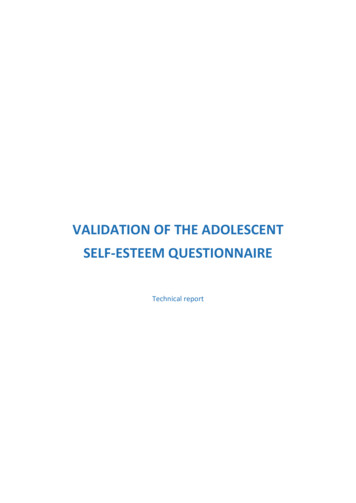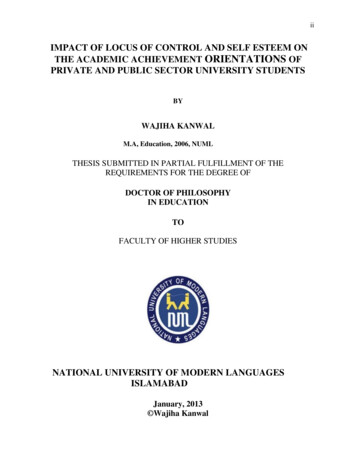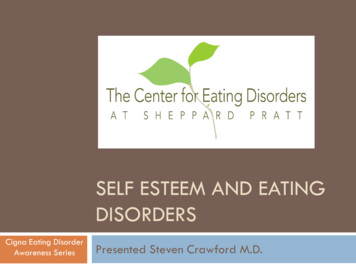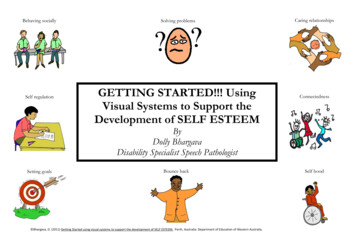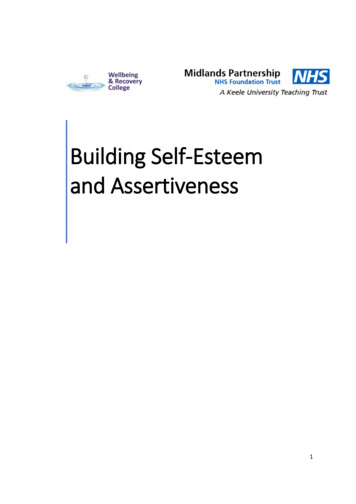
Transcription
Building Self-Esteemand Assertiveness1
Assertive approachesStuck RecordTechniqueAlso known as the broken record technique, itis a verbal response that is firm and conveys aclear message. It can work well in situationswhere the other person wants to argue,refuses to listen or is disorganised. It employsthe skill of calm persistence. The techniqueinvolves repeating what you want over andover again, without raising the tone of yourvoice, becoming irritated or drawn into theissue. Continual repetition ensures thediscussion doesn't get side tracked into anargument. The key is to stay calm, be clearabout what you want and stick to the point. 5FoggingFogging is a useful technique to deal withsomeone who may be behaving in anaggressive or manipulative manner. It canprevent the conversation from escalatingthrough agreement rather thandisagreement. Rather than arguing back,fogging gives a minimal response using calmlanguage that is neither defensive nor passiveto demands being made. It involves agreeingwith any truths that are said, even if they arecritical. By not responding in the expectedway (defensive or argumentative) the otherperson will cease confrontation, as thedesired effect isn't being achieved. It is calledfogging because you act like a 'wall of fog' intowhich arguments are thrown but not returned(Extracts from www.skillsyouneed.com)AuthenticityBeing Authentic means to be true to yourself,your feelings and your beliefs. However, thereare times where you wouldn’t reveal all thatyou are thinking and feeling. Being authenticinvolves giving an honest genuine responsewhen it’s appropriate and not going againstyour beliefs when it’s not. For example, if afriend is distressed and complaining aboutsome criticism that they have received, whichyou know is true, giving an honest responsemay not be appropriate in that moment. Itmay be more appropriate to comfort them inthat moment and talk supportively aboutauthentic thoughts later. On the whole,authentic behaviour is consistent with howyou truly feel and this reflects healthy selfesteem.Truthful and thoughtful communication isn’talways the easiest option; it often takescourage to be vulnerable, which in turn takespractice. The ability to express emotionsfreely, clearly and with clear intentions helpsto upholds healthy personal boundaries. Thisis essential for developing healthy selfesteem.Healthy BoundariesUnderstanding what our limits are inrelationships and setting boundaries is a skillthat isn’t often taught in any formal setting.Using the self-awareness techniques fromsession 1, anyone can learn what is right forthem and where their limits lie. Everyone canrelate to the experience of having theirpersonal boundaries crossed. If this happensoften, it can lead to negative thoughts andfeelings about ourselves and others, loweringself-esteem.2
ACTIVITY Personal BoundariesPersonal boundaries are limits that we set for ourselves within relationships. They are acceptableways for ourselves and others to behave that respects our own values and those of others. Whatfeels acceptable will vary from person to person so there is no right or wrong answers.The following items are types of behaviours that you may encounter in daily interactions withothers:Holding HandsTextShare stories from your lifeGiving a hugShaking HandsDiscuss your healthSharing personal problemsTell secretsGive your phone numberPhoning for a chatSay hello toChat on the computerEntering their homeShare food withStand close to themHave a joke with themDoing a favour for themTrust themList behaviours that feel acceptable to you in the spaces below:FamilyFriendsWork ColleaguesAcquaintancesStrangers3
Personal Boundaries continued Place a tick in the box for each row to show where your boundaries lie for each set ofpeople.Personal boundaries are limits that we set for ourselves within relationships. Ourboundaries can be tight or loose or healthy. Our boundaries can vary depending on who weare with and what culture we live in.TightAvoids close relationships, unlikely to ask for help, protective of personal information, detached,avoids other through fear of possible rejection.LooseOvershares personal information with others, difficulty saying no to the requests of others,overinvolved with others problems, dependent on the opinions of others, accepting ofmistreatment, fear of rejection if don’t comply.HealthyValues others opinions, doesn’t compromise needs for others, shares personal informationappropriately, knows personal needs and can communicate them, can say no and accept whenothers say no.TightLooseHealthyFamilyPartnerFriendsWork ColleaguesAcquaintancesStrangers- Adapted from Therapistaid.com5Extracts from www.skillsyouneed.com4
Learn more about what you can do to make a difference .Healthier Boundaries.A person with healthy boundaries can say ‘no’ to others when they want to but they arealso comfortable opening themselves up to relationships with others.Some helpful Tips Know your limits - the previous exercisewill help you identify where your limits liewith different groups of people. Yourboundary limits are unique to you.Knowing them before you enter asituation will help you to prevent anythingwhich you’re not comfortable with.Know your values- the values youidentified in week 1 will help you toprioritise these over others demandsasked of you. Your values are the thingsthat are most important to you and theseshape your boundaries.When asserting your needs andwants express them clearly withlanguage such as:Listen to your Emotions-if you“I’m not comfortable with this”experience feelings of discomfort orresentment, these can be signs that yourboundaries are being pushed beyondhealthy limits for you.“Please don’t do that”“Not at this time”“This doesn’t feel right”Self-Respect-reflect on whether you givemore respect to the needs of others thanyou do to your own needs. There aretimes when it is important to balance yourown needs with those of others.“I’m sorry I can’t do that for you”Flexibility-try to balance the amount of“This is not acceptable”giving and receiving. Some days you maygive more than you receive and vice versa.Make sure your relationships are two wayrather than one way.“This doesn’t work for me”“I’ve decided not to.”“I’m drawing the line at ”“I don’t want to do that”5
Learn more about what you can do to make a difference .Howard Gardener: DevelopmentalPsychologist and Researcher atHarvard UniversityAssertiveness take-away tipsUsing Confident Body LanguageFace the other person, make eye contactand use a calm steady tone of voice.Be RespectfulAvoid yelling, using put downs or givingthe silent treatment. Say “no” respectfullyand clearly and fairly. Your message willbe better received if you are respectful.CompromiseIt is possible to compromise sometimeswhilst still respecting your ownboundaries. This is a good way to softenthe “no” whilst respecting the otherperson. Listen to the needs of the otherperson.‘8 Intelligences - Theory of MultipleIntelligences Explained - Dr. Howard Gardner’.https://www.youtube.com/watch?v s2EdujrM0vABullet Journaling‘My bullet journal (and how Iuse it to help my mental health).https://www.youtube.com/watch?v VTKAKJc0xbw‘How to be a friend to yourself’https://www.youtube.com/watch?v wFUxiIjp-Nk(Therapist Aid)Plan Ahead‘Communication Styles- Assertive PassiveAggressive’Think about what you want to say and howyou want to say it before entering adifficult discussion.Clips from the coursehttps://www.youtube.com/watch?v MMc8AP9KhEMFoggingAmy Cuddy: Psychologist,Researcher and Speaker.‘Your body language may shape who you are’https://www.youtube.com/watch?v Ks Mh1QhMchttps://www.youtube.com/watch?v 7oKjW1OIjuw6
Reading recommended by some of our students Self-AwarenessAssertivenessSelf-Awareness: Getting to know thereal you. By Janelle Conena. 2016Assertiveness step by step. By DrWindy Dryden and DanielConstantinou. Sheldon Press 2004Self-Awareness and PersonalDevelopment: Resources forpsychotherapists and counsellors. ByChris Rose. 2011 Edition. Red GlobePressThe Self-Acceptance Project: How tobe kind and compassionate towardsyourself in any situation. By TamiSimon. 2016. Sounds TrueThe Assertiveness Workbook: How toexpress your ideas and stand up foryourself at work and in relationships.By Randy Paterson. New Harbinger2001Self-Acceptance. By Dr Harry Barry.2019. Orion Spring.Radical Self Forgiveness: The directpath to true self-acceptance. By ColinTipping. 2011. Sounds True.Self EsteemOvercoming Low Self Esteem, 2ndEdition: A self help guide usingcognitive behavioural techniques. ByDr Melanie Fennell. Robinson 2016Six Pillars of Self-Esteem. By NathanielBranden. Random House 19957
8
Self Esteem Overcoming Low Self Esteem, 2nd Edition: A self help guide using cognitive behavioural techniques. By Dr Melanie Fennell. Robinson 2016 Six Pillars of Self-Esteem. By Nathaniel Branden. Random House 1995 Assertiveness Assertiveness step by step. By Dr Windy Dryden and Daniel Constantinou. Sheldon Press 2004


